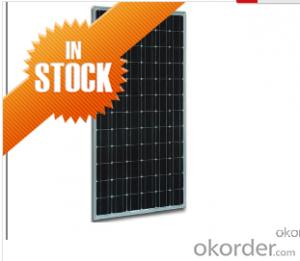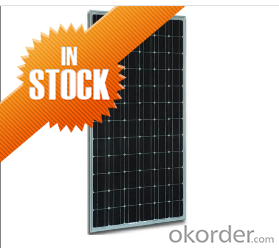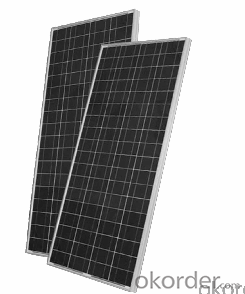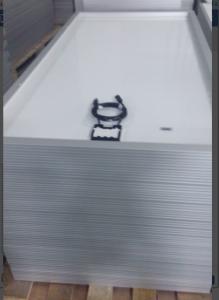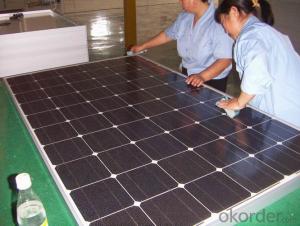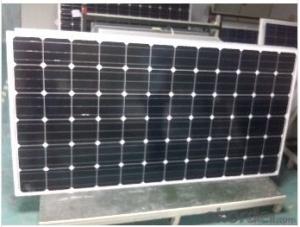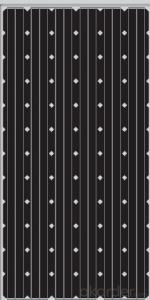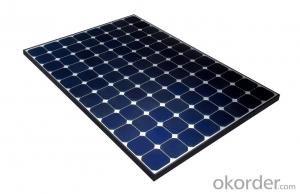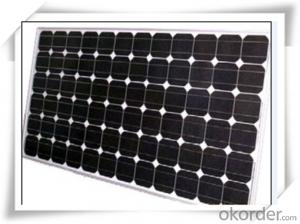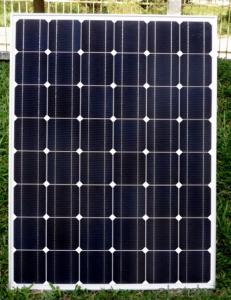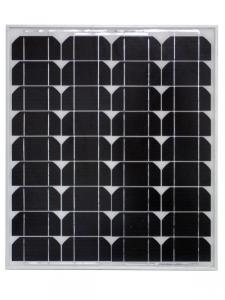Grape Solar Mono Solar Panels CNBM 280W-300W with Competitive Price
- Loading Port:
- Shanghai
- Payment Terms:
- TT OR LC
- Min Order Qty:
- 10 pc
- Supply Capability:
- 600000000 pc/month
OKorder Service Pledge
OKorder Financial Service
You Might Also Like
Product Description:
Introduction of Mono Solar Panels CNBM 280W-300W
CNBM Solar photovoltaic (PV) Panel is designed for large electrical power requirements. It is the optimal choice for both on-grid and off-grid power systems. CNBM Solar panel offers high performance of power per square foot of solar array. Monocrystalline silicon(c-Si): often made using the Czochralski process. Single-crystal wafer cells tend to be expensive, and because they are cut from cylindrical ingots, do not completely cover a square solar cell module without a substantial waste of refined silicon. Hence most c-Si panels have uncovered gaps at the four corners of the cells.
Characteristics of Mono Solar Panels CNBM 280W-300W
I.Solar Cell : High efficiency crystalline solar cell. Even if under the weak light, the solar module can produce maximum power output.
II.Tempered glass (toughened glass): Anti-reflecting coating and high transmission rate glass increase the power output and mechanical strength of solar module.
III.EVA and TPT: Using high quality EVA and TPT to prevent destroying and water.
IV.AI frame: Without screw, corner connection. 6 holes on the frame can be installed easily.
V.Junction box: Multi function junction box with water proof.
VI.Long lifetime: ≥25 years; Less power decrease.
VII.Good performance of preventing from atrocious weather such as wind and hails.
VIII.Resisting moisture and etching effectively, not effected by geology.
IX.The certificate issued by international authority: UL, TUV, IEC, VDE, CE.
Images:
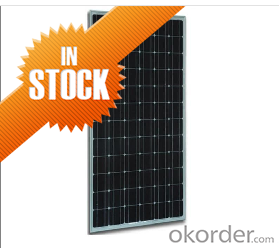
Standard Test Conditions of Mono Solar Panels CNBM 280W-300W
The opto-electrical specifications shown below are stabilized values being measured at Standard Test Conditions, Irradiance: 1000W/m2, Spectrum: AM1.5 at 25°C, The info below is subject to manufacturing tolerances. Where appropriate minutes of measurement are available and are used for the dimensioning of the installation.
FAQ: What's the advantages of CNBM?
CNBM Solar performance guarantees for 25 years
• 12 years guarantee for workmanship
• Timeliness of delivery
• Quality Products certified (TÜV, UL, CE, VDE, ISO)
CNBM International Corporation's products including Monocrystalline Solar Panel, Polycrystalline Solar Panel have received and enjoyed famous reputation in many countries and regions in the world .As a solar panel manufacturer in China, we strive to provide our customers with excellent service, superior products and unmatched value.
- Q: I have a cabin that is way out in the middle of no where, it would cost 000's of dollars to get power to it. If I have a 8,000 BTU air conditioner that runs on 25 volts and 5 amps (or 875 watts)How many solar panels will I need to run this during the day, plus charge the batteries to run it all night? How many batteries would I need
- It would just be cheaper to run the power lines back to the house but what ever you do DONT take electricity from the drop above the meter for free at night. That would be wrong! Lol sticking it to the man!
- Q: Do higher watt solar panels last longer, efficiency-wise? 3 installers gave me quotes with 3 different sunpower panels. The 225, 25, 20 watt panels. Whats the con and pro's of the different wattages?
- There is no difference between them besides their rated output. One may physically fit on you roof better than another, or look better, although the physical difference between those sizes is minimal. Go with whichever installer you trust, and is preferably NABCEP certified, or working towards NABCEP certification. Get references. Don't believe just because someone is an electrician they know how to install solar electric, it's a whole different animal. Make sure they are trained in installing solar.
- Q: Can solar panels be used in hot climates?
- Yes, solar panels can be used in hot climates. In fact, solar panels often perform better in hot weather as they rely on sunlight, not heat, to generate electricity. However, it's important to consider factors like panel efficiency, temperature coefficients, and proper installation to maximize their effectiveness in hot regions.
- Q: If I wanted to add solar panels to my home to produce on average, 8 kWh of electricity daily, how much do you estimate it would cost using state of the art technology?I live in Virginia (Washington DC Metro Area), and I have Dominion Power. I pay the following electric rates:Jun-Sep $0.0904/kWhOct-May $0.0776/kWhAnnual Ave: $0.0824/kWhDistribution charges add on approximately another $0.0228/kWh.How long would the ROI for an 8 kWh/day solar system be?
- Figure 8 hours of sun per day, so 8 kW-hr is a rate of kW, which is a medium sized panel, probably not enough to operate your house totally, unless you have a very small unit. Averaged over 24 hours, that is power at a rate of only 300 watts, enough for a TV. Average US home use is .2 kW, which over 24 hours is 29 kW-hr, plus you need extra for cloudy days, peak demands, and to charge batteries. You have to decide off-grid or on-grid, and if you want to (and are allowed to) sell excess power to the power company. Off gird, the cost of batteries and charge controller are a large part of the cost. On-grid, you have to purchase equipment approved by the power company to match your power with the grid. Panels will cost about $3 per watt, so for 000 watts that is $3000. Double that for installation, then add in cost of charge controller, inverter, batteries, etc. The last items depend on your alternatives, see paragraph above. .
- Q: How much space do solar panels require?
- The amount of space required for solar panels can vary depending on factors such as the type and size of the panels, their efficiency, and the energy needs of the system. On average, an average-sized residential solar panel system typically requires around 100-400 square feet of roof space. However, ground-mounted systems can require larger areas, and more efficient panels can generate the same amount of electricity in a smaller space.
- Q: About how much would it cost to purchase and install solar panels for the average American house so that the house can be off the power grid and use the same amount of electricity as it normally does?
- And even though the better technology is out there, it is not in mass production. Perhaps one day it will be, but it is not there presently Silicon wafer based solar cells Despite the numerous attempts at making better solar cells by using new and exotic materials, the reality is that the photovoltaics market is still dominated by silicon wafer-based solar cells (first-generation solar cells). This means that most solar cell manufacturers are equipped to produce these type of solar cells. Therefore, a large body of research is currently being done all over the world to create silicon wafer-based solar cells that can achieve higher conversion efficiency without an exorbitant increase in production cost. The aim of the research is to achieve the lowest $/watt solar cell design that is suitable for commercial production.
- Q: Is it as simple as buying the panels, an inverter and plugging it into a wall-socket, assuming it would just send power back into the outlet and supplement my house's electrical usage, or... Is it not that simple?Remember, I'm talking about a SMALL system, and I don't care how little power it'd make, or how uneconomical it would be.
- Not that simple. The N E C covers electrical systems and your state utility regulators cover what and how you can do it. As a practical consideration the inverter produces power and would have an outlet to tap it. Possibly a standard convenience outlet that is the same as your house devices. The problem is to provide a cord that does NOT have exposed hot conductors when it is plugged in and how do you isolate the system from the power grid. To do this you need both a reverse service device and transfer switch that will isolate the house from the grid while the inverter is operating.
- Q: Can solar panels be used to power swimming pools?
- Yes, solar panels can indeed be used to power swimming pools. Solar panels can generate electricity from sunlight, which can be used to operate pool pumps, heaters, and other equipment, reducing the reliance on traditional electricity sources and saving on energy costs.
- Q: trees vs solar panels who would win?
- Trees for sure. Their already plotting the overthrow of humans.
- Q: Can solar panels be installed on golf courses or recreational facilities?
- Yes, solar panels can be installed on golf courses or recreational facilities. These locations often have vast open spaces with ample sunlight, making them ideal for harnessing solar energy. Additionally, installing solar panels in these areas can help offset the energy demands of the facilities, reduce carbon emissions, and promote sustainability.
Send your message to us
Grape Solar Mono Solar Panels CNBM 280W-300W with Competitive Price
- Loading Port:
- Shanghai
- Payment Terms:
- TT OR LC
- Min Order Qty:
- 10 pc
- Supply Capability:
- 600000000 pc/month
OKorder Service Pledge
OKorder Financial Service
Similar products
Hot products
Hot Searches
